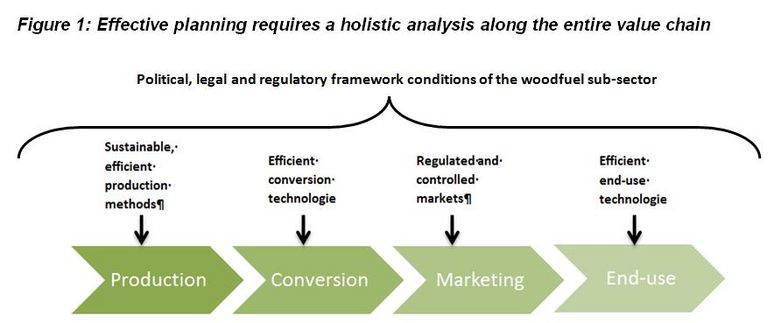Knowledge fuels change - Support energypedia!
For over 10 years, energypedia has been connecting energy experts around the world — helping them share knowledge, learn from each other, and accelerate the global energy transition.
Today, we ask for your support to keep this platform free and accessible to all.
Even a small contribution makes a big difference! If just 10–20% of our 60,000+ monthly visitors donated the equivalent of a cup of coffee — €5 — Energypedia would be fully funded for a whole year.
Is the knowledge you’ve gained through Energypedia this year worth €5 or more?
Your donation keeps the platform running, helps us create new knowledge products, and contributes directly to achieving SDG 7.
Thank you for your support, your donation, big or small, truly matters!
Inception Studies for Biomass Energy Supply Opportunities
Prerequisite: Comprehensive assessment of the wood-fuel value chain
Measures to promote sustainable wood-fuel supplies should always be synchronized with the modernization of the entire wood-energy sector, in recognition of the fact that wood-based energy is an environmentally friendly/renewable, socially adapted, and clean/low‐risk source of energy. Promoting wood-energy on this basis calls for a stepwise, holistic approach, aiming for the continuous, through gradual refinement/adaptation of pertinent framework conditions, organizational and procedural aspects, and technological development. Political will is pivotal to this end.
In order to enhance a sustainable, pro-poor, regional woodfuel supply complying with criteria of ecological sustainability and fostering a local economic upswing, a holistic analysis of the whole woodfuel value chain is required.
The following list of questions is not exhaustive but indicative, outlining salient issues that enable dignosis and analysis leading to better project design and implementation.
It should be borne in mind that all measures aiming to enhance the wood-fuel supply chain are based on common principles and draw on the assumptions that:
- Substantial quantities of wood-fuel can be produced sustainably without undue impacts on food production,
- Appropriate technologies for conversion and utilization exist or can be introduced,
- Biomass use provides environmental benefits by way of substituting non-renewable fuels, thereby contributing to GHG mitigation,
- There exist potentials for enhancing economic benefits in terms of added value and employment.
It should be noted, that in regard to ICS interventions a specific list of questions can be viewed under the following link Inception_Studies_for_ICS_opportunities.
When analyzing and comparing data it is of utmost importance to ensure that adequate conversion factors are applied and local units are converted to international standards equivalents.




















